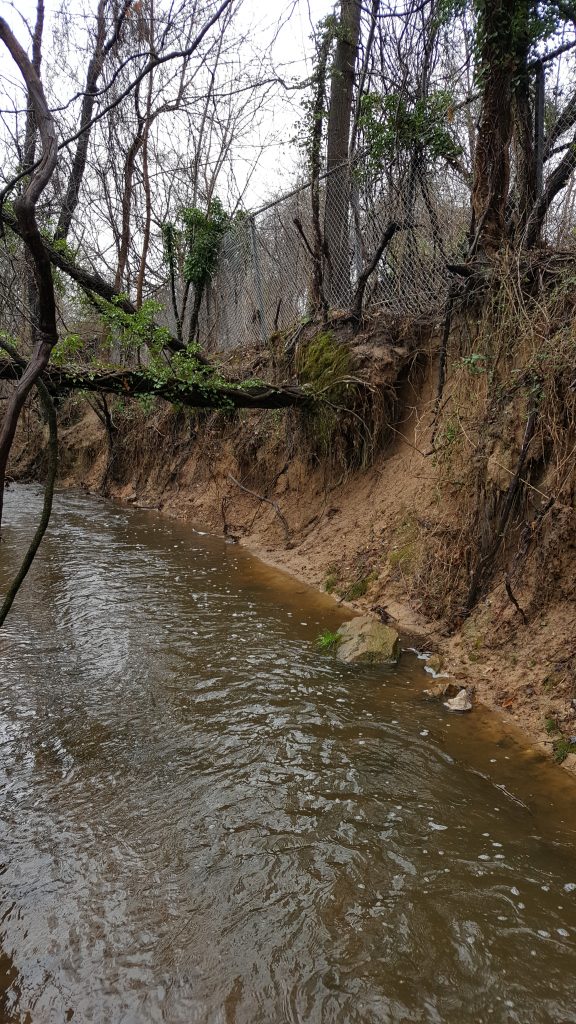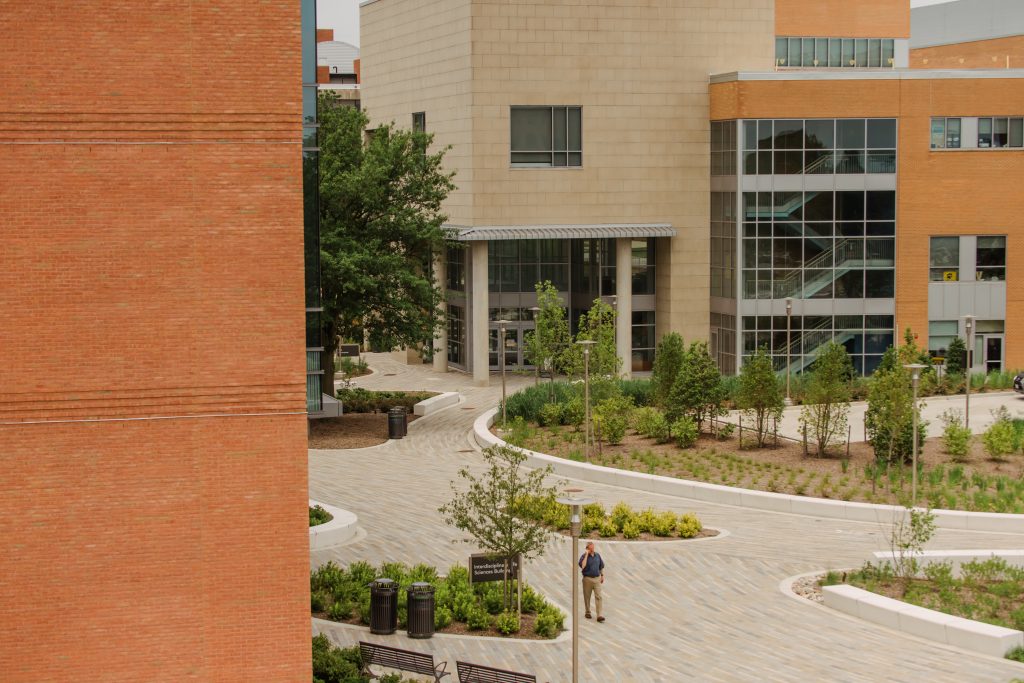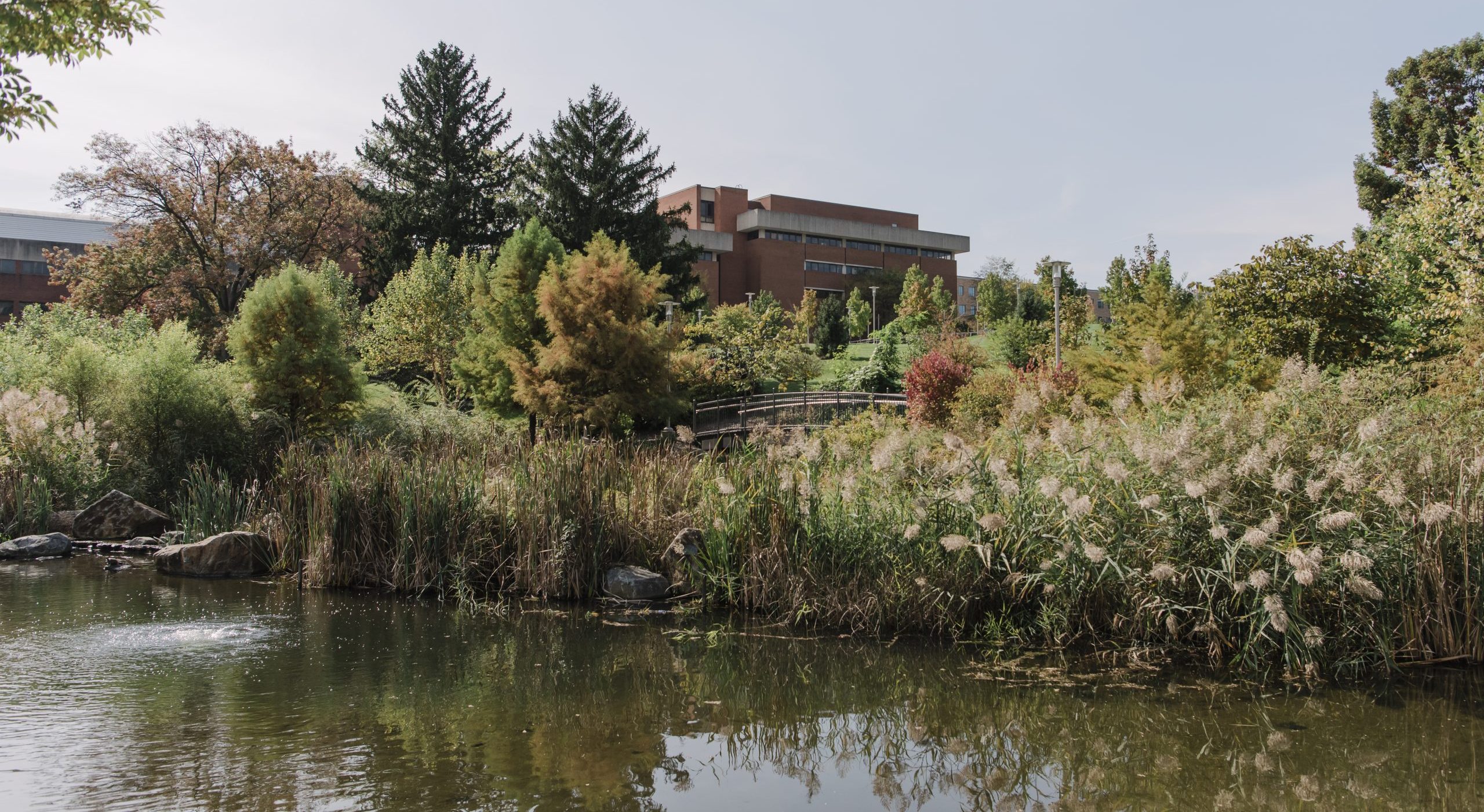A high-potential green space on the edge of UMBC’s main campus will see big changes in the coming months. A new $1 million grant from the Chesapeake and Atlantic Coastal Bays Trust Fund, combined with about $1.4 million of university investment, will fund a major stream restoration on campus. The stream is a small tributary of the West Branch Herbert Run, and it flows through campus by the Chesapeake Employers Insurance Arena and bwtech@UMBC. The stream is part of the Patapsco River and Chesapeake Bay watersheds.
“This project will not only create and enhance wetland and stream habitats and functions, it will also provide recreational enhancements such as walking trails with stream access and connection to other existing trails,” says Lenn Caron, associate vice president of facilities management.
Additionally, he notes, “the restored stream will elevate UMBC’s aesthetic appeal and provide a pleasant natural environment for members of the campus and local community for recreation, exercise and watershed education.”
Restoring Herbert Run is part of UMBC’s Institutional Management Plan, a stormwater master plan put in place in 2014. The plan empowers UMBC to “make decisions that serve the campus’s interests on a broader scale—on a watershed basis,” rather than addressing stormwater requirements for new construction projects in isolation, explains Larry Hennessey, associate director of design and construction services and the lead on the restoration work. “This is the outcome of many years of stormwater planning.”

Recreating a healthy stream
The need for the restoration is a result of decades of growth at UMBC and in the surrounding community. In a forest, soil absorbs and filters a large percentage of precipitation exactly where it falls, leaving only a small portion to flow into nearby streams. However, development leads to an increase in surfaces that water can’t penetrate, like concrete and building roofs. This generates more runoff that enters streams. Because the natural stream channel didn’t form to handle that much water, the increased runoff quickly erodes the stream banks.
As the bank erodes, “the stream channel becomes so deep that it’s no longer connected to the floodplain,” Hennessey says. The water can’t spread out and seep into adjacent land, so it flows with greater speed and force through the stream, worsening erosion. “It becomes a self-perpetuating problem,” Hennessey says.
The restoration project will “reconnect the stream with the floodplain by raising the streambed and adding natural features in the stream to slow down the flow,” Hennessey explains. “By spreading the water out, when you do get a big storm event, the impacts won’t be concentrated in a small area. The stream will function the way it was intended to function.”

Welcoming visitors—wild and human
Additional benefits of the project abound. Eroded, fast-flowing streams don’t support nearly as much wildlife as healthy streams connected to the floodplain. While it may alarm some observers that the stream restoration involves removing trees, “Lower portions of the trees are left in the stream to create deeper pools and riffles,” Hennessey says. These microhabitats attract animals like frogs, dragonflies, crayfish, and even herons. “This is going to significantly improve our ecosystem,” he explains.
The restoration will also enhance the experience of Herbert Run for humans. The Herbert Run Greenway walking path traverses the Conservation and Environmental Research Area (CERA) and follows the stream as it meanders across the southeast quadrant of campus.
Along the portion of the stream to be restored, concrete stairs lead down to a frequently submerged concrete walkway, and the land beside the stream is clogged with invasive plants. Once the project is finished, however, a healthier streamside and new nature trail dotted with informational signage will greet visitors in this section of the greenway.

New tech, new strategies
The campus implemented its first stormwater management facilities decades ago by installing ponds near some buildings to collect stormwater runoff. The ponds prevented a rush of fast-flowing water into streams during storms, slowing erosion. These projects focused on stormwater quantity, but did little to address the quality of the runoff. The runoff would deposit sediment in streams, causing more problems.
This challenge is far from unique to UMBC. “The entire Chesapeake Bay is filled with plumes of sediment after a rain event, because this is happening everywhere,” Hennessey says. “The ponds were a good first step, but they didn’t really solve the problem. We still had detrimental effects of the stormwater runoff coming out of the ponds.”
Over time, as technology and understanding of the damage caused by runoff increased, the strategies changed. New projects, like UMBC’s Interdisciplinary Life Sciences Building, include bioretention facilities that both slow the flow of water to streams and use a special medium underground to effectively filter out sediment and other harmful compounds.

A commitment to sustainability
Hennessey has been with UMBC since 2007 and has a deep personal commitment to landscape stewardship. Previous projects he’s been involved with included landscape conversions, such as from a lawn to a no-mow pollinator meadow, and improving the functionality of older stormwater management installations, like the ponds.
He is excited to see this new project launch after almost a decade of planning. There was some question as to whether the project as originally designed would come to fruition due to funding constraints, but the grant from Chesapeake and Atlantic Coastal Bays Trust Fund removed that barrier.
The project “highlights our goal of continuous improvement, both visually and functionally,” Caron notes. Simpler options, like street-sweeping, might have met environmental requirements, but would not have yielded the same long-term benefits. The decision to pursue a stream restoration on campus, Caron says, “demonstrates our commitment to environmental sustainability.”
Banner image: The UMBC Library Pond and adjacent vegetation, upgraded in 2014, serve as a stormwater management facility on campus. Photo by Marlayna Demond ’11 for UMBC.
Tags: campus, sustainability

